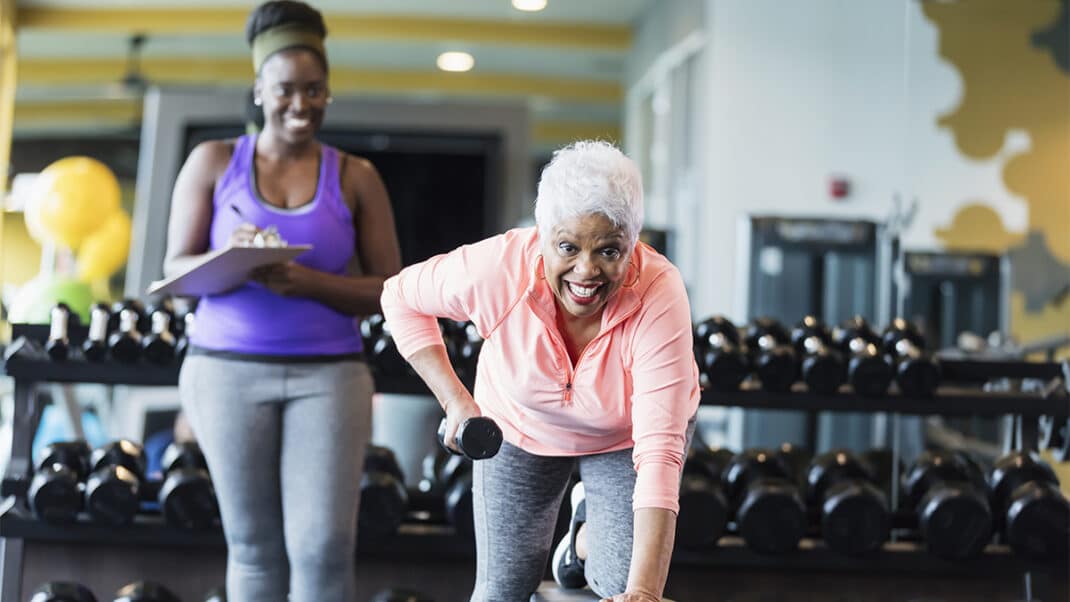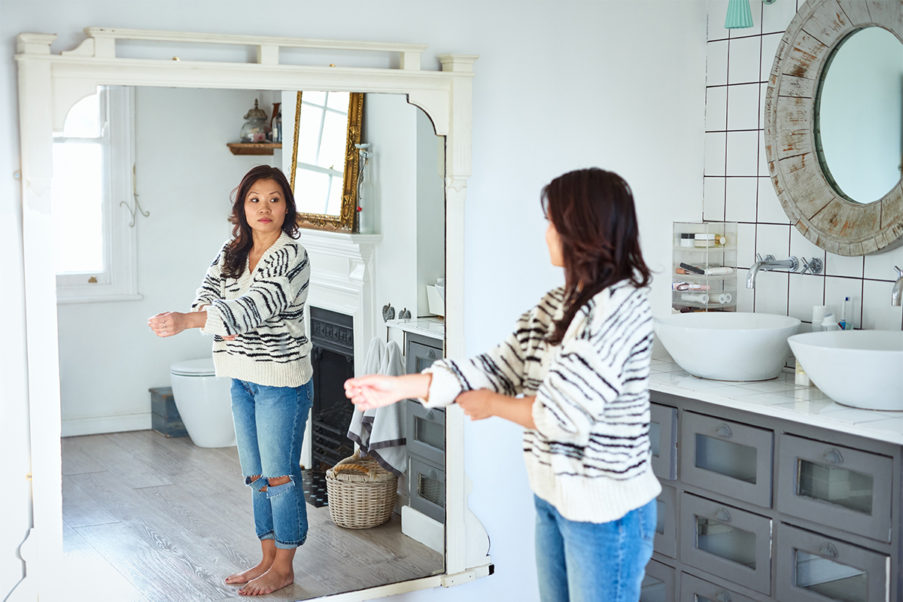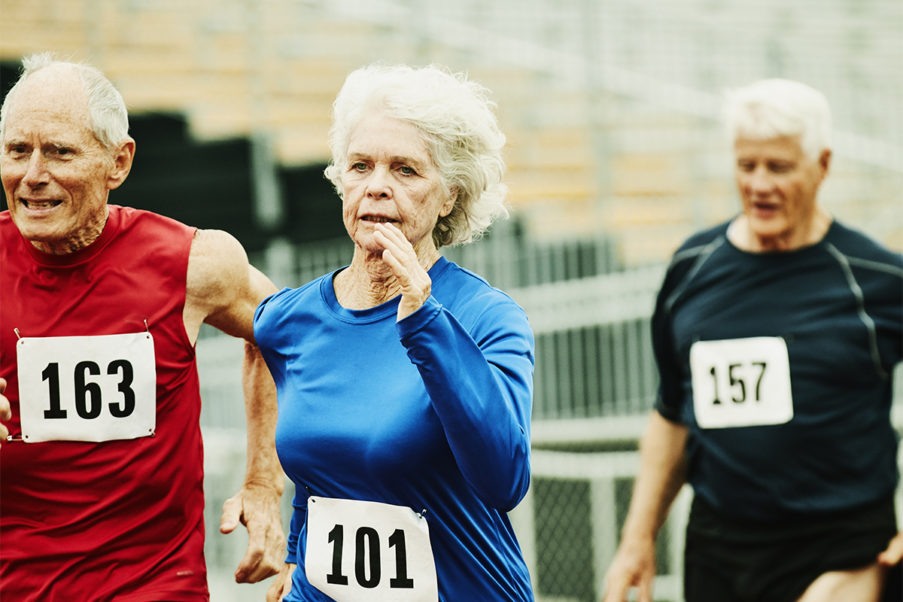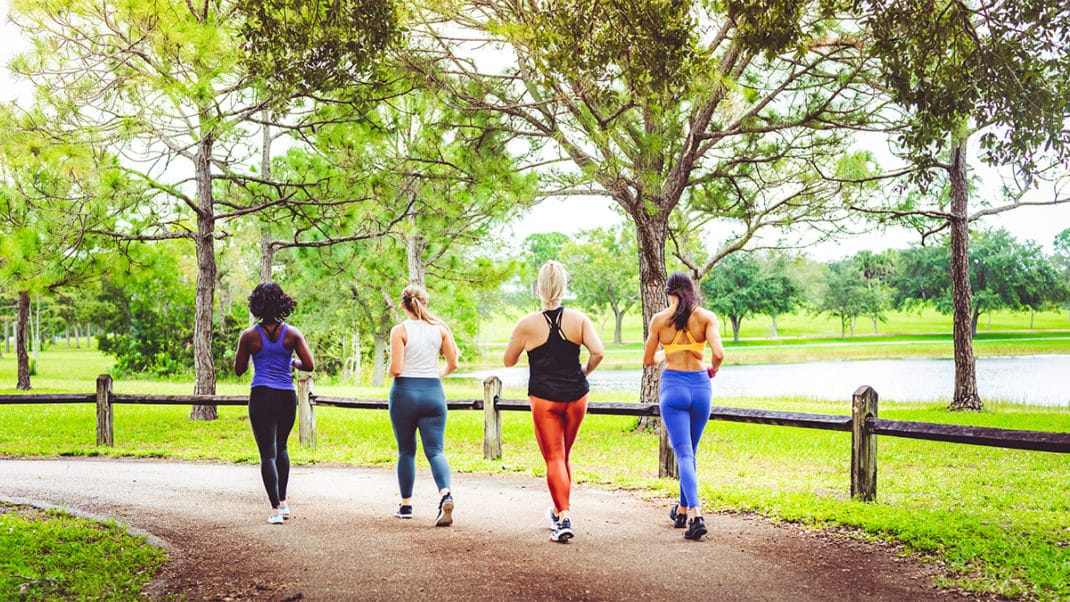Effects of Aging on the Neuromuscular System
Physiological changes to the neuromuscular system are a normal part of aging, but they can affect the human movement system in ways we’re not used to.
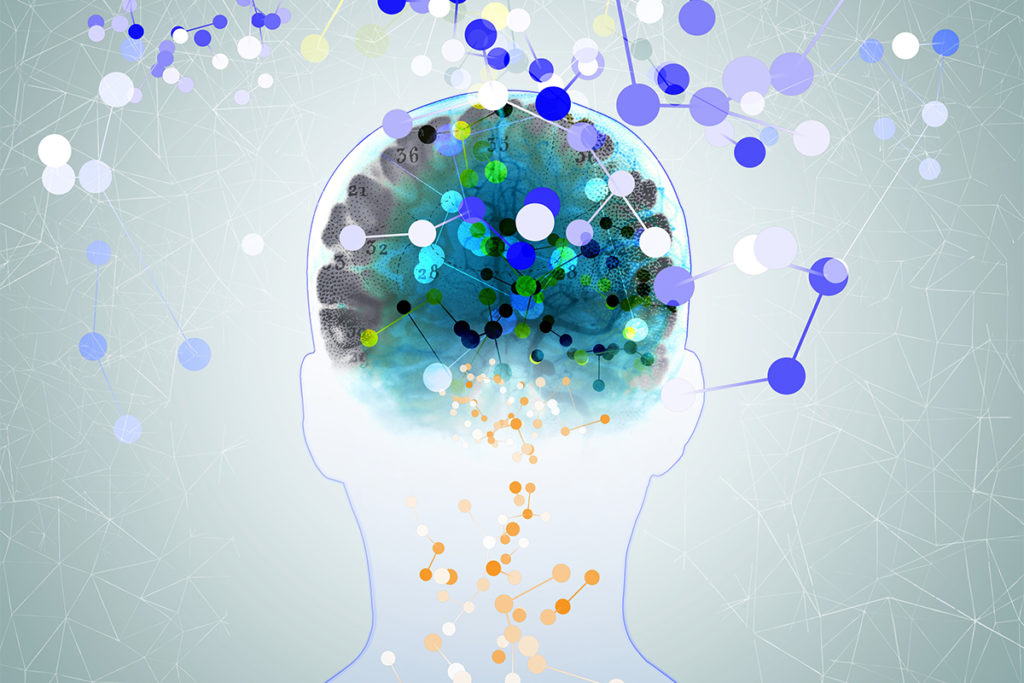
Most people think of the “baby boom” as a huge uptick in the birthrate following World War II, and while that’s true, here’s another view: By the end of 2030, all baby boomers will be over the age of 65 (United States Census Bureau 2018), resulting in a “senior boom.” As this shift occurs, it’s increasingly likely that fitness professionals will need to work with people who are experiencing normal age-related physiological changes. Understanding how these changes impact seniors is essential for trainers and instructors wanting to best serve this population’s unique needs.
In terms of exercise, one of the most important physiological systems is the neuromuscular system, which includes the nervous and muscular systems and how they communicate to control human movement.
The Aging Neuromuscular System: An Overview
In addition to the brain losing neurons and total weight as we age, there is a thinning of the primary communication structures between neurons (Sanes & Jessell 2013). This diminishes the capacity for brain signals to travel between the central and peripheral nervous systems, which in turn can hinder the muscles’ ability to communicate with the brain and vice versa. The age-related neuromuscular changes that ensue are considered normal.
Neuromuscular changes in the aging population often include muscle weakness, reduced joint proprioception and decreased power (Takacs et al. 2013). These declines can significantly affect dynamic postural control and balance, altering gait mechanics, causing faulty perception and increasing injury risk (Hicks et al. 2012).
While these shifts represent the observable changes to the human movement system, the chain reaction begins at the smallest level: the motor unit, which is the elementary unit of motor control. Also impacted are tiny sensory receptors, called mechanoreceptors, which are responsible for transmitting messages that assist in proprioception, or the body’s ability to sense its position relative to the environment. These two structures will be the focus of the remainder of this article.
See also: Peak Neuromuscular Power for Your Athlete Clients
A Review of the Motor Unit
The motor unit is the functional unit of the neuromuscular system. This unit comprises a nerve cell called a motor neuron and all of the muscle fibers it innervates. A typical muscle is controlled by a few hundred motor neurons whose cell bodies are found in the brain and spinal cord.
The motor unit receives inputs from descending pathways of the brain or from sensory receptors within the muscles of the same motor unit, through reflexes. Transmission of nerve impulses from one neuron to another occurs at specific sites called synapses, each of which consists of an axon terminal of the incoming nerve, the presynaptic cell, the synaptic cleft and a target post-synaptic cell (Siegelbaum & Kandel 2013). In the case of the neuromuscular system, a synapse is referred to as a neuromuscular junction.
How Motor Units Change With Age
The motor unit and associated components have a major impact on the overall function of the neuromuscular system. Some motor unit changes are expected as a natural process of aging. Consider the following research:
Decrease in Number, Increase in Size
A research review by Hunter, Pereira & Keenan (2016) highlights that the result of aging is a net decrease in the total number of motor units. However, the motor units themselves appear to adapt to this change by increasing in size to maintain smooth communication between the two systems (nervous and muscular).
In alignment with these find-ings, Fling, Knight & Kamen (2009) recruited both young and old adults to investigate how the relationship between motor unit size and recruitment threshold changes as people get older. The researchers used a computational program to determine the size of the motor units and found they increased with age. This was true of muscles in both the hand (first dorsal interosseous) and the lower leg (anterior tibialis).
Increase in motor unit Size, Decrease in Firing Rate
Ling et al. (2009) found that age was associated with an increase in motor unit size but a decline in motor unit firing rate. They learned that many participants older than 75 years of age had motor units twice the size of those in younger participants. Further, alterations in size and firing rates appeared to become most noticeable with a decline in muscle mass during aging.
Fling, Knight & Kamen reported that the Henneman’s size principle (which states that small neurons are more excitable and contract first) was still apparent in older participants. This could indicate that bigger motor units are slower to discharge, potentially decreasing initial force output and power.
Supporting this, Kirk et al. (2019) found that motor unit discharge rates were significantly slower in subjects ages 77–88 compared with those ages 22–33. Given these findings, it is reasonable to conclude that muscle weakness in the older population may have more to do with slower firing rates than with motor unit size.
In sum: As muscle mass declines, the size of individual motor units may increase to develop or maintain existing neuronal connections with individual muscle fibers, as an adaptation strategy. However, outsized motor units appear to be slower to fire, which may help explain the reduction in muscle strength exhibited by older adults.
Resistance training can assist in offsetting strength and power losses in the older population. A recent meta-analysis found that resistance training alone, or in conjunction with other types of training, could increase strength by as much as 37%, muscle mass by up to 7.5% and power by up to 8.2% (Lopez et al. 2018). While some degree of muscle mass loss is expected with aging, numerous studies have indicated that losses can be mitigated with regular resistance training. Resistance training helps to maintain or increase muscle mass by improving motor unit firing rate and the recruitment of motor units.
A Review of Mechanoreceptors
Proprioception is a communicative function of sensory receptors known as proprioceptors. Among these are mechanosensory neurons, also known as mechanoreceptors.
Found in muscles, skin, tendons and joints, mechanoreceptors sense the physical deformation of bodily tissue (Gardner & Johnson 2013). Any pressure or force that distorts or stretches tissue will stimulate or excite the local mechanoreceptors.
Mechanoreceptors are specialized and react to different stimulation (Patel et al. 2009). For example, some respond to more rapid movements (as in the muscle spindle), whereas others respond to a sustained stretch force or tension (as in the Golgi tendon organ) (Gardner & Johnson 2013). Mechanoreceptors in muscles and joints convey vital information about joint position, posture and movement—all of which play a role in proprioception and motor control and are vital to the performance of physical activity and exercise.
See also: Power Up Your Aging Clients
How Mechanoreceptors Change With Age
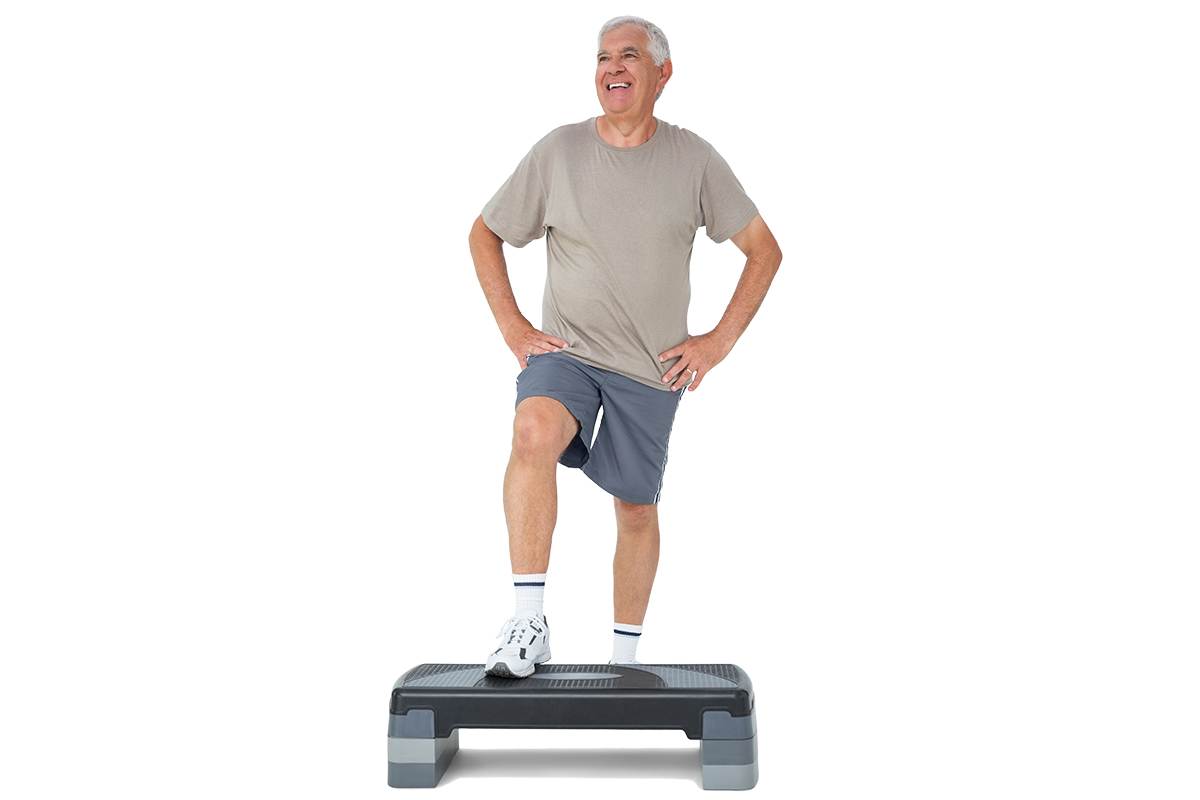
Older individuals may rely more on vision for balance, owing to mechanoreceptive alterations.
A decline in the sensitivity of the mechanoreceptors is considered a normal part of aging, but it does have a negative impact on overall motor function (Hunter, Pereira & Keenan 2016). Consider these findings:
Decrease in Sensation, Decrease in Coordination
Communication between the nervous system and the muscular system slowly decreases with age. As mechanoreceptive sensation declines, there is a loss of sensory information, and the ability to coordinate movement is impaired.
In a landmark study, Swallow (1966) diligently measured the size of anterior tibial nerves, finding a sizable loss of large myelinated fibers in elderly individuals. The scientific techniques Swallow used are out of date now, but these findings did highlight a relationship between age and the diameter of nerve fibers.
The size of a nerve fiber is closely related to the speed of neuronal transmission, and a smaller fiber is associated with a slower speed.
Decrease in Size, Decrease in Balance
This slower speed could have a significant impact on postural control and balance functions. In one exploration of this hypothesis, Choy, Brauer & Nitz (2003) found that proprioceptive declines seemed to be consistent as age increases.
The researchers recruited 125 women ages 20–80 to perform a modified Clinical Test for the Sensory Inter-action of Balance (CTSIB) and Single-Limb Stance Test (SLST) with eyes opened and closed. They found that postural stability naturally declined with age, which was expected. However, they also identified specific challenges within the later decades of life.
For example, women in their 50s had significant difficulty performing the SLST with eyes closed, and women in their 60s were challenged during the bilateral stance on a foam pad. By their seventh decade, women could not perform a bilateral stance on a firm surface with eyes closed. Importantly, older individuals may rely more on vision for balance than younger people, owing to mechanoreceptive alterations and reduced joint proprioception.
Decrease in Sensation, Decrease in Stability
Similarly, Patel et al. explored how altered mechanoreceptive sensation would influence stability in older adults. The researchers used repeated calf vibrations to modify postural stability. By measuring the perception of vibration and tactile sensitivity, Patel et al. found that, overall, older individuals had poor sensation compared with younger individuals. However, as the study continued, the repeated calf vibrations eventually led to an increase in stability. These findings imply that vibration eventually improved proprioceptive function by stimulating the mechanoreceptors. Further, the increase in stability occurred at a greater rate in the elderly.
More recently, Koehler-McNicholas et al. (2019) expanded on this notion of increasing stimulation to excite the mechanoreceptors and improve postural stability. The researchers found that stimulating the plantar receptors in those with known declines in mechanoreceptive sensation improved Functional Gait Assessment scores. This study implies that including stimulation, such as low-level vibration, in training programs for older adults could improve their postural stability and balance. Or, in the absence of vibration technology, a simple proprioceptive device, like a thin foam pad, might help accomplish these goals.
Proprioception declines in older adults for a variety of reasons. The studies here highlight that reduced mechanoreceptor sensitivity is a vital piece of the puzzle.
See also: Power Training vs. Strength Training for Older Adults
Independence: The Ultimate Benefit for Older Adults
The literature provides evidence that changes in motor unit characteristics and proprioceptive function are normal with aging—and that these changes can negatively influence motor performance. In simple terms, as age advances, neuron fiber size decreases as motor unit size increases, and the discharge rate of the nervous system also changes. The decline in normal functioning of motor units may be related to deterioration of proprioceptive functions.
While this can be limiting, it does not mean that older adults cannot enjoy—and benefit greatly from—a structured, progressive, systematic exercise program designed with these changes in mind. Being aware of the impact of physical changes, impairments to visual and vestibular systems, and increasing stability challenges is the first step. Adapting programming to address these declines and using methods to stimulate mechanoreceptors may improve overall function in the older population and, in turn, reward their efforts with a greater number of years of independence.
How You Can Prevent Dangerous Falls
Any changes in communication between the nervous and muscular systems are likely to result in a loss of balance, which is a risk factor in the older population. Falling is a leading cause of death and injuries among older adults. In 2014, almost one-third of this group reported a fall, and approximately 27,000 fatalities were related to falls (Bergen, Stevens & Burns 2016). While birthdays won’t stop accumulating, the studies presented in this article suggest that risks associated with neuromuscular changes can be mitigated with the use of balance training. See “Sample Program: Balance Training for Older Adults,” left, for an idea of what is possible for this population.
Balance Training for Older Adults
Balance training (for any age group) should progress through three levels: stabilization, strength and power. These are also the three levels in the integrated training system known as the NASM Optimum Performance Training™ model, created by the National Academy of Sports Medicine.
Below are examples of balance training at each of these levels.
Tip: Balance training in NASM’s OPT™ model is not performed in isolation. Flexibility, core and resistance training are included, all of which support the effectiveness of balance training.
Balance Stabilization
The goal of balance training at the stabilization level is to teach the client how to maintain a neutral and stable static joint position.
Exercises include basics, such as holding a single-leg stance for a period of time (from several seconds up to 30 seconds, depending on ability and comfort). Progressions typically include adding movements by other extremities, such as a reach with the floating leg, which is intended to slightly shift the center of mass and increase the challenge on balance mechanisms.
Tools that may help are vibrating devices such as foam rollers. Applying a low-level vibration to the plantar surface of the foot and lower-leg muscles before training may improve mechanoreceptive function, according to studies referenced in this article. Turn the roller to the lowest setting, and have the client roll the foot and lower leg for about 30 seconds each on both sides.
For each exercise: Perform 1–3 sets of up-to-30-second holds.
Sample move: Single-leg balance with reach.
Balance Strength
The goal of balance training at the strength level is to add more dynamic eccentric and concentric movement to the stance leg.
Exercises could include a single-leg squat or something like a step-up to balance. Note: Full range of motion is neither necessary nor expected in the older population. For example, in the single-leg squat, the fitness professional could ask the client to slightly flex the knee and lower just a few inches, then return to the starting position. The key is to ensure that the client maintains optimal posture and control through whatever range is chosen.
For each move: Perform 2–4 sets of 8–12 repetitions.
Sample move: Single-leg squat with small range of motion.
Balance Power
The goal of balance training at the power level is to begin developing the ability to decelerate increased forces.
Exercises for younger populations might include a move like a single-leg hop with stabilization. However, if the older client is unable to safely hop, then an exercise such as a quick box step-down with stabilization is appropriate. Stepping off a small box will increase the deceleration demands of the exercise.
For each exercise: Perform 2–3 sets of 8–12 repetitions.
Sample move: Box jump-down or step-down.
References
Bergen, G., Stevens, M.R., & Burns, E.R. 2016. Falls and fall injuries among adults aged ≥65 years—United States, 2014. Centers for Disease Control and Prevention. Accessed Jan. 4, 2021: cdc.gov/mmwr/volumes/65/wr/mm6537a2.htm.
Choy, N.L., Brauer, S., & Nitz, J. 2003. Changes in postural stability in women aged 20 to 80 years. The Journals of Gerontology: Series A, 58 (6), M525–30.
Fling, B.W., Knight, C.A., & Kamen, G. 2009. Relationships between motor unit size and recruitment threshold in older adults: Implications for the size principle. Experimental Brain Research, 197 (2), 125–33.
Frontera, W.R., et al. 2008. Muscle fiber size and function in elderly humans: A longitudinal study. Journal of Applied Physiology, 105 (2), 637–42.
Gardner, E.P., & Johnson, K.O. 2013. The somatosensory system: Receptors and central pathways. In E.R. Kandel, et al. (Eds.), Principles of Neural Science (5th ed.) New York: McGraw Hill.
Hicks, G.E., et al. 2012. Absolute strength and loss of strength as predictors of mobility decline in older adults: The InCHIANTI study. The Journals of Gerontology: Series A, 67A (1), 66–73.
Hunter, S.K., Pereira, H.M., & Keenan, K.G. 2016. The aging neuromuscular system and motor performance. Journal of Applied Physiology, 121 (4), 982–95.
Kirk, E.A., et al. 2019. Human motor unit characteristics of the superior trapezius muscle with age-related comparisons. Journal of Neurophysiology, 122 (2), 823–32.
Koehler-McNicholas, S.R., et al. 2019. Neuromodulation to improve gait and balance function using a sensory neuroprosthesis in people who report insensate feet: A randomized control cross-over study. PLOS ONE, 14 (4), e0216212.
Ling, S.M., et al. 2009. Age-associated changes in motor unit physiology: Observations from the Baltimore Longitudinal Study of Aging. Archives of Physical Medicine and Rehabilitation, 90 (7), 1237–40.
Lopez, P., et al. 2018. Benefits of resistance training in physically frail elderly: A systematic review. Aging Clinical and Experimental Research, 80 (8), 889–99.
Patel, M., et al. 2009. The contribution of mechanoreceptive sensation on stability and adaptation in the young and elderly. European Journal of Applied Physiology, 105 (2), 167–73.
Sanes, J.R., & Jessell, T.M. 2013. The aging brain. In E.R. Kandel, et al. (Eds.), Principles of Neural Science (5th ed.) New York: McGraw Hill.
Siegelbaum, S.A., & Kandel, E.R. 2013. Overview of synaptic transmission. In E.R. Kandel, et al. (Eds.), Principles of Neural Science (5th ed.) New York: McGraw Hill.
Swallow, M. 1966. Fibre size and content of the anterior tibial nerve of the foot. Journal of Neurology, Neurosurgery & and Psychiatry, 29 (3), 205–13.
Takacs, J., et al. 2013. The role of neuromuscular changes in aging and knee osteoarthritis on dynamic postural control. Aging and Disease, 4 (2), 84–99.
United States Census Bureau. 2018. Older people projected to outnumber children for first time in U.S. history, Accessed Dec. 10, 2020: census.gov/newsroom/press-releases/2018/cb18-41-population-projections.html#:~:text=By%202030%2C%20all%20baby%20boomers%20will%20be%20older%20than%20age%2065.&text=%E2%80%9CBy%202034%20(previously%202035),decade%20for%20the%20U.S.%20population.
Kyle Stull, DHSc
Kyle Stull, DHSc, is a content development manager at NASM and an instructor for the Department of Health and Human Performance at Concordia University. Stull has a doctorate in health sciences and a master’s degree in rehabilitative science, and he is a licensed massage therapist. His research interests include self-myofascial release and the influence of mobility on performance and biomechanics.
